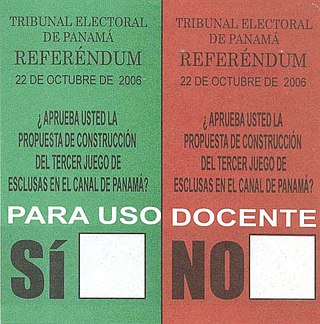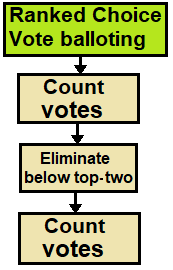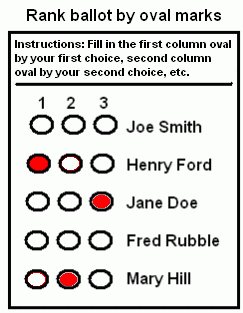Plurality voting refers to electoral systems in which a candidate who polls more than any other is elected. In systems based on single-member districts, it elects just one member per district and may also be referred to as first-past-the-post (FPTP), single-member plurality (SMP/SMDP). A system that elects multiple winners elected at once with the plurality rule and where each voter casts multiple X votes in a multi-seat district is referred to as plurality block voting. A semi-proportional system that elects multiple winners elected at once with the plurality rule and where each voter casts just one vote in a multi-seat district is known as single non-transferable voting.

The two-round system (TRS), also known as runoff voting, second ballot, or ballotage, is a voting method used to elect a single candidate, where voters cast a single vote for their preferred candidate. It generally ensures a majoritarian result, not a simple-plurality result as under first past the post. Under the two-round election system, the election process usually proceeds to a second round only if in the first round no candidate received an absolute majority of votes cast, or some other lower prescribed percentage. Under the two-round system, usually only the two candidates who received the most votes in the first round, or only those candidates who received above a prescribed proportion of the votes, are candidates in the second round. Other candidates are excluded from the second round.

The single transferable vote (STV), sometimes known as proportional ranked choice voting (P-RCV), is a multi-winner electoral system in which each voter casts a single vote in the form of a ranked-choice ballot. Voters have the option to rank candidates, and their vote may be transferred according to alternate preferences if their preferred candidate is eliminated or elected with surplus votes, so that their vote is used to elect someone they prefer over others in the running. STV aims to approach proportional representation based on votes cast in the district where it is used, so that each vote is worth about the same as another. Formally, STV satisfies a fairness criterion known as proportionality for solid coalitions.

Voting is a method by which a group, such as a meeting or an electorate, convenes together for the purpose of making a collective decision or expressing an opinion usually following discussions, debates or election campaigns. Democracies elect holders of high office by voting. Residents of a jurisdiction represented by an elected official are called "constituents", and the constituents who choose to cast a ballot for their chosen candidate are called "voters." There are different systems for collecting votes, but while many of the systems used in decision-making can also be used as electoral systems, any which cater to proportional representation can only be used in elections.
Block voting, also known as bloc voting, refers to certain electoral systems where multiple candidates are elected simultaneously. They do not guarantee minority representation and allow a group of voters to ensure that only their preferred candidates are elected. In these systems, a voter can select as many candidates as there are open seats. That is, the voter has as many votes to cast as the number of seats to fill. The block voting systems are among various election systems available for use in multi-member districts where the voting system allows for the selection of multiple winners at once.
Electoral systems of the Australian states and territories are broadly similar to the electoral system used in federal elections in Australia.

The 1926 Alberta general election was held on June 28, 1926, to elect members of the Legislative Assembly of Alberta. The United Farmers of Alberta government that had first been elected in 1921 was re-elected, taking a majority of the seats in the Alberta Legislature. Herbert Greenfield had resigned as United Farmers leader and premier, and John E. Brownlee led the UFA to this second election victory, increasing the UFA's number of seats.
Historically, the single transferable vote (STV) electoral system has seen a series of relatively modest periods of usage and disusage throughout the world; however, today it is seeing increasing popularity and proposed implementation as a method of proportional representation and a goal of electoral reform. STV has been used in many different local, regional and national electoral systems, as well as in various other types of bodies, around the world.

One of the ways in which ranked voting systems vary is whether an individual vote must express a minimum number of preferences to avoid being considered invalid. Possibilities are:
Instant-runoff voting (IRV) is a voting method used in single-seat elections with more than two candidates. Instead of voting only for a single candidate, voters in IRV elections can rank the candidates in order of preference. Ballots are initially counted for each elector's top choice, losing candidates are eliminated, and ballots for losing candidates are redistributed until one candidate is the top remaining choice of a majority of the voters. When the field is reduced to two, it has become an "instant runoff" that allows a comparison of the top two candidates head-to-head.

The contingent vote is an electoral system used to elect a single representative in which a candidate requires a majority of votes to win. It is a form of preferential voting. The voter ranks the candidates in order of preference, and when the votes are counted, the first preference votes only are counted. If no candidate has a majority of the votes cast, then all but the two leading candidates are eliminated and the votes received by the eliminated candidates are distributed among the two remaining candidates according to voters' preferences. This ensures that one candidate achieves a majority and is declared elected.
The later-no-harm criterion is a voting system criterion first formulated by Douglas Woodall. Woodall defined the criterion by saying that "[a]dding a later preference to a ballot should not harm any candidate already listed." For example, a ranked voting method in which a voter adding a 3rd preference could reduce the likelihood of their 1st preference being selected, fails later-no-harm.
The multiple non-transferable vote (MNTV) is a group of voting system, in which voters elect several representatives at once, with each voter having more than one vote. MNTV uses multi-member electoral districts or only one district, which contains all voters, which is used to provide at-large representation.
Plurality block voting, also known as plurality-at-large voting, bloc vote or block voting (BV) is a non-proportional voting system for electing representatives in multi-winner elections. Each voter may cast as many votes as the number of seats to be filled. The usual result when the candidates divide into parties is that the most popular party in the district sees its full slate of candidates elected in a seemingly landslide victory.
The Borda count is a family of positional voting rules which gives each candidate, for each ballot, a number of points corresponding to the number of candidates ranked lower. In the original variant, the lowest-ranked candidate gets 0 points, the next-lowest gets 1 point, etc., and the highest-ranked candidate gets n − 1 points, where n is the number of candidates. Once all votes have been counted, the option or candidate with the most points is the winner. The Borda count is intended to elect broadly acceptable options or candidates, rather than those preferred by a majority, and so is often described as a consensus-based voting system rather than a majoritarian one.
Instant-runoff voting (IRV), also known as plurality with elimination or plurality loser, is a ranked-choice voting system that modifies plurality by repeatedly eliminating the last-place winner until only one candidate is left. In the United Kingdom, it is generally called the alternative vote (AV). In the United States, IRV is often referred to as ranked-choice voting (RCV), by way of conflation with ranked voting systems in general.

An electoral system or voting system is a set of rules that determine how elections and referendums are conducted and how their results are determined. Electoral systems are used in politics to elect governments, while non-political elections may take place in business, non-profit organisations and informal organisations. These rules govern all aspects of the voting process: when elections occur, who is allowed to vote, who can stand as a candidate, how ballots are marked and cast, how the ballots are counted, how votes translate into the election outcome, limits on campaign spending, and other factors that can affect the result. Political electoral systems are defined by constitutions and electoral laws, are typically conducted by election commissions, and can use multiple types of elections for different offices.
A majoritarian electoral system is an electoral system where the candidate with the most votes takes the seat using the winner-takes-all principle and in this way provides majoritarian representation. However, there are many electoral systems considered majoritarian based on different definitions, including types of at-large majoritarian representation such as block voting or party block voting, but district-based majoritarian systems such as first-past-the-post voting (FPTP/SMP). Where two candidates are in the running, the one with the most votes will have a majority, but where there are three or more candidates, it often happens that no candidate takes a majority of the votes.

The term ranked voting, also known as preferential voting or ranked-choice voting, pertains to any voting system where voters indicate a rank to order candidates or options—in a sequence from first, second, third, and onwards—on their ballots. Ranked voting systems vary based on the ballot marking process, how preferences are tabulated and counted, the number of seats available for election, and whether voters are allowed to rank candidates equally.
The mixed ballot transferable vote (MBTV) refers to a type of vote linkage-based mixed-member electoral system where a group of members are elected on local (lower) tier, for example in single-member districts (SMDs). Other members are elected on a compensatory national (upper) tier from a list and voters cast a single ballot where they may indicate their preferences separately.










